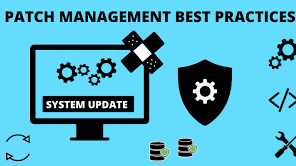Introduction
Imagine leaving your house door unlocked at night—sounds risky, right? Similarly, unpatched vulnerabilities in your software and systems are like open doors for hackers. Patch management is your digital “lock and key” to prevent unauthorized access and keep attackers at bay.
Abstract
Overview
Patch management is the process of regularly updating software to fix bugs, security holes, or vulnerabilities. By applying patches, you reinforce your systems against potential threats, just as you would repair a leaky roof before the rain comes pouring in.
Vulnerabilities are the unlocked doors through which cybercriminals break into your system. Patch management acts as a proactive security measure, closing those doors and ensuring your systems stay secure by addressing software bugs and weaknesses before they can be exploited.


[Disclaimer: This blog post is for informational purposes only and should not be construed as legal or financial advice. Organizations should consult with legal counsel and regulatory authorities to ensure compliance with reporting requirements.]
Mandatory
It’s essential for maintaining security standards and regulatory compliance. Patching regularly ensures you're meeting industry requirements like those in GDPR, HIPAA, and PCI-DSS, which demand up-to-date security measures.
Applicability
Every organization, big or small, relies on patch management. It’s especially critical for industries dealing with sensitive data, like finance, healthcare, and technology, where vulnerabilities can lead to severe breaches.
Regulatory or Company Interest?
Regulations require regular patching as part of a robust cybersecurity framework. Failing to patch can lead to data breaches, compliance violations, and fines.
Key Guidelines
Set up an automated patch management system.
Prioritize critical patches first.
Regularly audit and review the patching process.
Test patches before applying them to live systems.


Key Implications
Unpatched vulnerabilities lead to serious risks, including data loss, financial harm, and regulatory penalties. Proper patch management helps you mitigate these risks effectively.
Countries with Adoption or Influence
Countries such as the US, UK, and EU have strict requirements for patch management to safeguard against cyber threats and comply with regulations.
International Frameworks Influenced
International frameworks like NIST, ISO 27001, and CIS Controls emphasize the importance of patch management to ensure a secure environment.
Regional and Industry-Specific Frameworks
Sectors like finance (PCI-DSS) and healthcare (HIPAA) have specific mandates for maintaining secure, updated systems to protect sensitive data.
Secure Your Digital Identity with SecureKnots
Contact us to learn more about our cybersecurity services and ensure your organization meets cybersecurity requirements.


Conclusion
Patch management is crucial to securing systems from vulnerabilities. It’s not just about fixing problems but preventing future ones. By consistently applying patches and staying proactive, you can strengthen your defenses against cyberattacks.
How SecureKnots Can Help
At SecureKnots, we specialize in vulnerability assessments and penetration testing (VAPT) to identify unpatched vulnerabilities in your systems. We offer security awareness training to educate your team on best practices for patch management, and our ransomware attack simulation services ensure that your defenses are ready for any potential threat. Trust SecureKnots to keep your systems secure with expert patch management strategies and support!
This blog focuses on the importance of securing employee access to internal systems while showcasing how SecureKnots can help organizations strengthen their access controls. It is informative and engaging, highlighting the significance of Patch Management. Let me know if you need further adjustments!
Thank you for your attention! If you have any inquiries about cybersecurity requirements or need expert guidance, please don't hesitate to contact SecureKnots.
This should wrap up the blog and fulfill the promise made in the previous one!
Patch Management
Think of patch management like fixing a leaky roof. If you ignore it, water will keep leaking in, causing more damage over time. Patches are like quick fixes for bugs or weaknesses in your software, preventing them from turning into bigger problems. Regularly updating your software with the latest patches can keep your systems strong and secure.
WITH OUR SHORT BLOGS
STAY UP TO DATE
Copy Rights @ 2023 SecureKnots. All Rights Reserved.
CONTACT US
Contact@Secureknots.com
USA
+1-302-601-2346
+1-302-608-6708
INDIA
080-31658865
GET IN TOUCH
